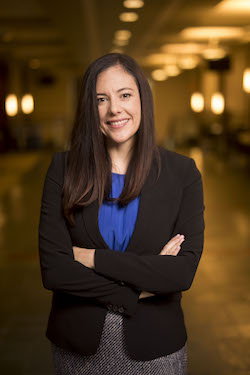
About half a million Americans, roughly the population of Miami, currently describe their gender as nonbinary—neither man nor woman—and our regulatory framework needs to do a better job of including them, says Jessica Clarke, assistant professor of law at Vanderbilt Law School. In a paper recently published in the Harvard Law Review, “They, Them and Theirs,” Clarke proposes a legal toolkit for those seeking reforms that would protect the rights of nonbinary people.
“My approach to this is not to say, ‘Let’s ban gender,’ or, ‘We should give everyone a new set of categories to pick from and build law and policy around those categories instead,’” Clarke said. “I think we need to look at each context in which the law uses sex or gender categories and ask ourselves: What are the interests served by these categories? What are the alternatives? What would be the consequences of pursuing those alternatives? And what would be the best one for this or that context?”
Clarke writes that there is no single solution that works in all cases, but that civil rights law offers a number of options: Third-gender recognition, sex neutrality and thoughtful integration into a binary system when alternatives are not feasible.
Third-gender recognition
Third-gender recognition means making space for nonbinary individuals to identify themselves officially as something other than men or women. Driver’s licenses and other identification documents, for example, could easily accommodate a nonbinary category. If the goal is to validate a person’s gender identity, this is not a perfect solution, Clarke says, since it does not recognize the diversity of nonbinary genders., However, she says it would be a good first step toward a more inclusive system.
Sex neutrality
Sex neutrality is the practice of eliminating sex or gender identification altogether in contexts where it does not matter. For example, Clarke asserts that there is no pragmatic reason to designate single-occupancy restrooms by gender. She said that while gender is still a very important part of most people’s identities, we should be willing to reconsider whether sorting people by sex or gender is absolutely necessary to the outcome we are trying to achieve with a rule or regulation.
Thoughtful integration into binary systems
Thoughtful integration means building in accommodations for nonbinary individuals in sex-segregated binary settings. For example, because there is not yet a critical mass of support for sex-desegregated sports, the solution may be to include nonbinary athletes within the preexisting binary system according to the rules that apply to other transgender athletes.
Clarke goes on to describe in more detail how these various strategies could be used in common settings, including schools, athletic teams, workplaces, restrooms, and health care facilities.
At the end of the day, Clarke says, her goals with this project are to encourage scholars and policymakers to take a hard look at the regulatory role that sex and gender play in law and society, and to put forth solutions for how to adjust our approach to commonly occurring contexts to make them more inclusive.
“I want people to take what nonbinary people say about their gender identities seriously and ask themselves, ‘Why can’t we respect nonbinary people just like we respect men and women?’” Clarke said. “The project of including nonbinary people may result in legal and social changes that benefit everyone. Even if people disagree about nonbinary gender identities for ideological reasons, they may find out there are pragmatic reasons to include nonbinary people in law and in our lives.”